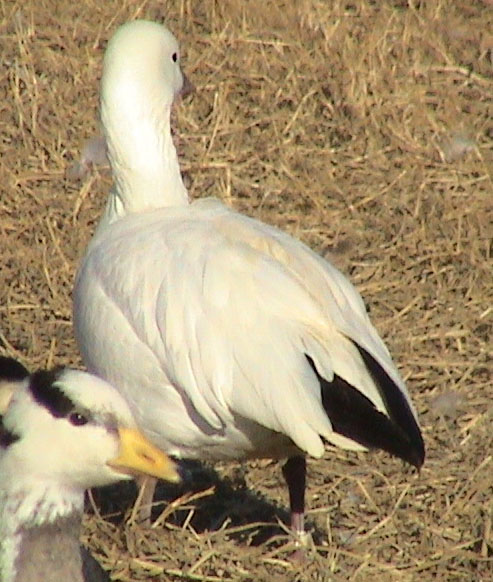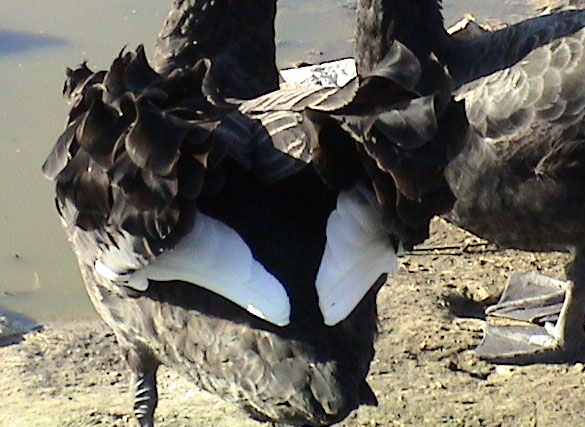Well, there are a few different ways I do this.
1) CLIPPING
On some of my more expensive birds like eiders other seas ducks, they are fullwinged yet I keep them out in an open top area. I only clip the primary wing feathers off one side , on these paticular birds I have not wanted to risk pinion on them because of the age of the birds and the expense of them, but the down fall to this is that if I don't watch them very close for a few days after they start molt and regrowth of feathers they begin to fly. You have a time frame of a week after you see those wings are full before they actually begin to fly. The feathers have not dried and are not strong yet, so catch them when you see them start exersising those wings and re-clip. With the sea ducks and a few others once a year is all I need to do this, and some rare geese. NEVER CLIP A WING THAT IS GROWING BLOOD FEATHERS these feathers are a direct blood vessel and you will bleed the bird to death.
2) PINIONING
Pinioning is the best way to render a bird totally flight less if done correctly, not too short and not too long. Nothing I hate worse than seeing a bird that has been pinioned way too short it's very unattractive to the birds and hard to handle them with out a wing to get a hold of
Method A Pinioning is best done day after hatch, with the last joint of one of the wings clipped off with a sharp pair of shears. There will be little blood if any at this age, the longer you wait the more chance of bleeding on young birds because their little bodies are growing fast and need all the energy they have to grow. What I do on baby birds that are also sexed at day old is to pinion off the right wing of males and the left wing of females. This is also a good rule of thumb to do when banding birds as well, males right females left. With most birds it is always advisable to double check the sex of a bird once it is grown because sexing babies can be tricky and no one is 100% accurate. This method of pinion is best for swans geese and birds that are same color and description when mature ( canada geese, snow geese, mutes blacks, ect, ect...)
Method B Pinioning of a grown birds/ducks, (I will get to geese and swans next) I just pinioned several grown ducks yesterday evening. In most books about the subject it explains how to tie off the wing and pluck feathers and make a circular cut around the skin and preform a major surgery. Well, this is all fine if you have the time and want to in my opinon, stress the birds even more than what you are about to do to them by cutting off one of their wings. My method though it may not be what the Dr. ordered works very well and fast and the birds are free and swimming again immedatly. I use a good sharp pair of boning scissors or a pair of my electrical side cutters both work well and are good clean cuts, I take the birds into by left hand and hold them with my arm and hand tucked under my arm to keep them still. Since I am right handed I always pinion grown birds on right wing, easy for me. I pull the wing out and in one quick cut just in front of the small thumb feathers, leaving that batch of feathers to act a protection on the new cut, I cut the wing bone and all primary feathers off in about 2 seconds. I release the birds right out into the water so that they can bath and clean the wound. Within a min or 2 the wing has stopped bleeding and the birds are left on the ponds to heal until such a time that I need to catch them again for transport. Never once have I lost a bird to this.
Method CGeese and Swans. 1st I will never pinion a large goose or swan because the size of the birds and the bones and vessels are too large. I recommend on the large birds to go ahead and use a vet or to tendon clip. On smaller geese such as egyptians and cacklers and other small breeds like these it is possible to pinion with the same method I used above with the exception of using bigger shears and putting a bit of blood stop on them before releasing onto the pond.
3) TENDON CLIPPING
Tendon clipping is a method I do not use often and I am not real good at it because it does take a little more time and surgery is preformed. But, I have found that tendon clipping has not done well on small ducks or small geese because they tend to heal well enough to fly again; athough not as well. Tendon clipping is a much nicer apperance to the birds that have it though because they still have both wings and will still cross the neatly on their backs. I just went out side to take some photos of tendon clipped birds to show how nice they look with the wings crossed, natural appearance. To tendon clip I take the bird and bend the wing back against it body in a natural resting position. With a razor knife I cut into the joint where the wing bends, severing the tendon, if you do not go into the area and clip out a small section it will heal back. I have found a faster and less stressful method, after cutting clean thru the tendon secure the wing tightly closed with an electrical zip ties until the wing has healed. With the ties on there the wing is immobile and heals in the close position where it will only ever open about 1/3 the way back after you take off the band. Thus, healed and flightless.
 Ross goose, tendon clip Jan 2003
Ross goose, tendon clip Jan 2003
 Australian goose, tendon clip Jan 2003
Australian goose, tendon clip Jan 2003
The last method that I have used
4) RUBBER BAND (casteration type)
Pluck the primary wing feathers near the joint where they met the secondary wing feathers open up the band and slide it over the wing until it's just under the knuckle (thumb) feathers and let the band do the rest. Within a few weeks the wing end will drop off and leave smooth clean scar. I only use this when it's a bird that has been injured or has angel wing because it will get all the bad wing off clean and no more bad appearance to that side of bird.
Well, I hope this info helps. Any questions feel free to ask. You may contact me at Wild Waterfowl Breeders forum or my website, Swan Haven Waterfowl
Michael Baker
Swan Haven Waterfowl
Wills Point, Tx